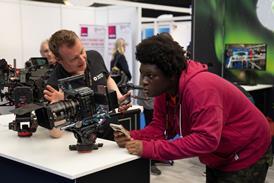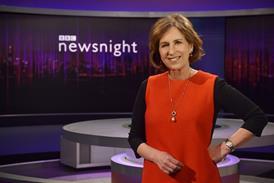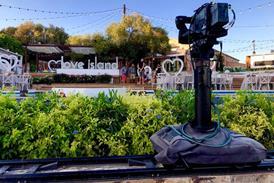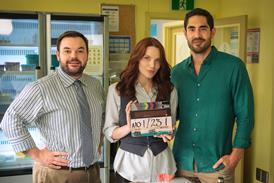The Channel 4 commission is a flag ship event in the horse racing calendar and the production team will use a range of technologies to get the best possible pictures.
Included amongst these technologies are nine wireless camera systems from Link Research supplied by equipment hire company Broadcast RF. Working with outside broadcast facility NEP Visions, the wireless camera team will provide:
Wireless steadicam for parade ring work, close-ups of the runners and riders and winners
‘Mac Cam', a dedicated wireless camera for following pundit John McCririck
‘Tracker A', one of the main race cameras, which is mounted on the lead chase vehicle following the horses around the track. This is provided by Aerial Camera Systems.
‘Tracker B', which backs up Tracker A. This is also provided by Aerial Camera Systems.
A reporter cam for talking heads
Two handheld wireless cameras for roaming work
A jib fitted to a land rover for shots of the start of each race
In this set-up, NEP Visions provides the cameras and Broadcast RF provides the Link Research wireless camera backs, transmitters, special mounts and racking systems.
Most of the cameras - both line and wireless - are made by Thomson. Sony cameras are used for the trackers.
Mark Houghton, general manager of Broadcast RF, believes that having all those wireless frequencies in one place is a challenge.
He said: “In terms of horse racing it doesn't get much bigger. There are 12 wireless systems in total plus all the other cameras and this makes it a pretty big event. Most of it is logistics in terms of frequencies. Anytime that you have more than couple of RF cameras in one place you have problems with interference with other people and with yourself. There is a lot of kit. And it's certainly a challenge.”
Houghton said that production of the event is also growing. “It's slightly bigger than last year which was slightly bigger than the year before. As the technology grows they [Highflyer] do grow with it. It's the biggest horse racing event we will do.”
Places other kit cannot reach
Using the Link Research systems allows Broadcast RF - and the production team - to get to places they couldn't do with standard cameras or other wireless systems.
“Link kit is quite light and compact,” explained Houghton. “It makes the event very do-able. The Cheltenham coverage does push the boundaries. The venue can give you a surprise though. All our best plans are put to the test if we get there and something is wrong like a cable is missing or a fibre is broken.”
John Mulcahy, managing director of Link Research, says his company has worked closely with Broadcast RF and the result has been some very impressive live productions.
He said: “Link's equipment is widely used in all of the live sports environments, from stadiums, motorsports and marathons to horseracing. Our high performance LMS-T modulation is a big advantage and is unique to Link.
“Our SD/HD transmitters and receivers and our wide range of antennas, amplifiers and accessories and unmatched Cellular Diversity technology for large area coverage give our customers the tools they need to deliver outstanding coverage in any environment."
Industry concern
Wireless camera technology is topical at the moment as the frequencies used - between 2 and 3 GHz - are about to be sold off by Ofcom to the highest bidder, which is likely to be mobile phone and mobile broadband companies.
It is causing some concern for programme makers. Joint Frequency Management Group (JFMG) Ltd, the dedicated frequency band manager for programme-making and special events, looks after spectrum for Cheltenham. It said in its most recent newsletter to members:
“Whilst licensees have been well aware of the impending loss of [spectrum] for release to the market, it is the risk of adjacent channel interference caused by the auctioning of these bands to mobile users that is of real concern.
“The group is also working to ensure PMSE users can successfully operate along-side each other at busy events. We hope that re-organisation of the remaining 2GHz bands and the creation of a draft code of practice covering transmitter and receiver performance will help the News and OB operators better cope with the reduction in available channels.”
Higher frequencies
Ofcom, the regulator, wants programme makers to use a higher frequency band. A spokesperson told Broadcast:
“In preparing the award of the 2.6GHz band, we have worked with PMSE users and taken their views carefully into account, for example in considering adjacency issues. More generally, PMSE users have been reporting increasing demand for spectrum use and we are working with them to identify suitable ways for them to gain access to spectrum such as at 7.5 GHz.”
Houghton said that he feels like programme makers are being “squeezed out a bit in terms of radio cameras and frequencies.”
“It's all being sold off to wireless communications providers including mobile phone operators,” he said. “We can't afford the millions of pounds for frequencies that they are willing to pay. At the moment it's alright, but it's changing. As a company we're going to have to adapt.
“On this event, most of it is under our control. The news broadcasters have their own allocated channels. They can turn up. There will be no other broadcaster - other than ITV West. But they have a pre-assigned license. What we've got is temporary licenses. And we've found enough for this year. Next year we might not. It does actually really threaten big events like Cheltenham.”
Enough to share
As a result of the proposed changes to spectrum allocation, broadcasters, hire firms and facilities have formed a working group to discuss options with Ofcom. The ‘Spectrum for Programme Makers Forum' was inaugurated last summer. Malcolm Smith, head of news gathering operations at ITN, is part of the group. He said the next step is to ensure there is enough frequencies to go round
“We've had a number of meetings with Ofcom about our concerns over access to spectrum for Programme Makers,” he said. “We are seeking to ensure that programme makers have access to enough spectrum so we can continue to cover news and events effectively. Ofcom has suggested a band manager that would look after all the spectrum that programme makers need - the question is how much would they charge for that spectrum?”
Ofcom will award the 2.6 GHz band allocation in spring/summer 2008.
C4's coverage of the Cheltenham Festival is produced by High Flyer. The outside broadcast facility is NEP Visions. Specialist cameras are provided by Broadcast RF and Aerial Camera Systems.
The Cheltenham Festival runs from 11 to 14 March 2008.




























No comments yet